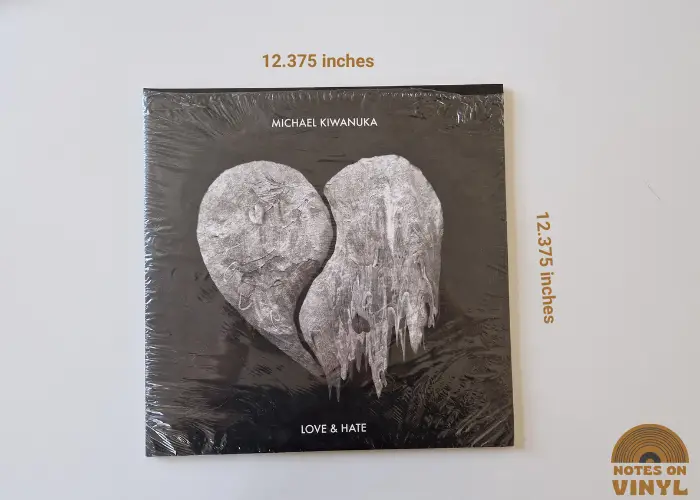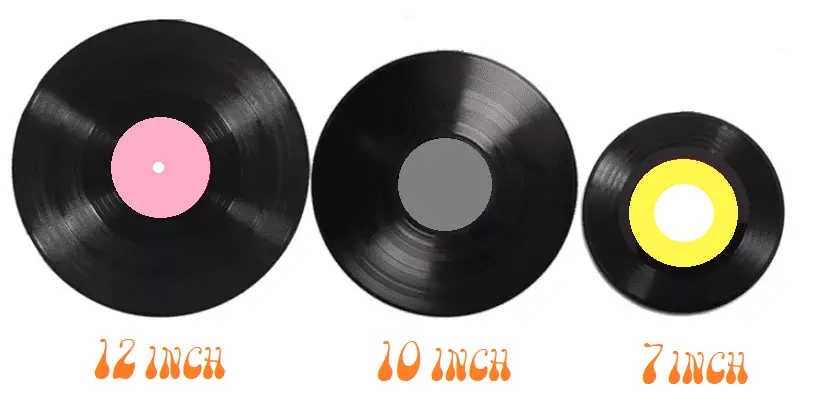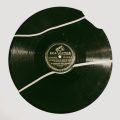Have you found yourself sitting back in your big comfy armchair with a piping hot cup of tea, taking in the sounds of your favorite record and the visual emblazoned onto the album’s sleeve, before all of a sudden wondering just how this art came to be in the first place?
Or, perhaps you have been in a similar situation, and instead have wondered why certain parts of the sleeve have become blurry in the process of printing?
Whatever your reason for being here, it is our intention today to elucidate why vinyl record sleeve dimensions are so important, how they can have an impact on the overall art produced, and why the particulars really are so important.

How Big is the Cover of a Record?
The size of the typical vinyl record sleeve dimensions is 12.375 inches by 12.375 inches (12.375″x12.375″) or 31.43 cm by 31.43 cm square
So, to begin our investigations on record sleeve dimensions, we must first firmly grasp the size of the cover itself. This might seem self-explanatory, but you would be surprised. For example, in the case of a 12-inch record, we would surely expect the album cover to be 12 inches from corner to corner, and yet this is not the case, for there needs to be some breathing space for the record, lest it be damaged in transit and the like.

With this breathing space taken into account alongside the 12 inches of the record in question, we approach a sum of about 12.375 inches square from each corner to the other. There is not so much breathing room with regards to these dimensions, for this is an industry-standard with every effort made to follow these guidelines. If we imagine this in centimeters, which I am aware that some people prefer, then we can see the 12.375 inches as 31.43 cm.
By contrast, the cover of a CD (or Compact Disc) is at least three times smaller than that of a record, catering to the considerably reduced size of the disc. The CD dominated the music market after vinyl records were popular, for, like cassette tapes, they are smaller and more efficient and able to hold more data within these smaller bounds.
CD’s can hold as much as 74 minutes to 80 minutes of music depending on the supplier, supposedly the case because the original creator at Sony’s favorite classical symphony was this length. If we compare it to the sizes of a record, we get a disc that is around 4.7 inches in diameter, which, when accounting for the necessary breathing room, means the album cover ought to be between 4.724 inches and 4.974 inches.
How Big Should the Art be?
The size, fidelity and type of image used as the art for an album can vary almost infinitely between releases, though any artist ought to strive to at least use a high-quality rendering of the album art, no matter its inherent quality. Seeing as LP album covers are inherently larger, they need to be considered duly, for any album art pressed onto a record sleeve is going to be magnified, and thus any defects enlarged.
It is not uncommon to purchase a record these days and to notice that certain parts of the image are muddied due to a low pixel rate of the image. Digital technology has done a number on this kind of thing and it feels as though there is scarcely any turning back.
This is a problem far more for the more independent producers and record labels who are working on more of a budget, with less shareholders, less expectations, and less of a fanbase. It is a sadness overall, but does make it feel even more special when an independent release can be depended upon for these aesthetic considerations.
It is, therefore, our recommendation that any artist wanting to send their album art to be pressed vinyl style ought to use an image that is at least 1600 pixels by 1600 pixels. This is only a minimum, however, with the bigger and more professional labels insisting on a baseline level of at least 3000 pixels by 3000 pixels.
The album covers of vinyl records are often rendered in DPI or Dots Per Inch. A 10 inch record, for example, would require artwork at least 3000 pixels squared, which would result in 300 DPI, a fairly strict industry standard.
The Three Main Record Sizes
If we are to get into the details of album cover dimensions, we might do best to also come to terms with the records which these sleeves contain. There are three main record sizes, to be exact, the 12-inch, the 10-inch, and the 7-inch, with the foremost and lattermost being far more common than the 10-inch record in the middle, who has not seen altogether very much popularity since the new vinyl boom. Coming to at least a mutual agreement about the various vinyl record types will unlock our understanding of a whole host of other interrelated things too.

12 inch
Of the three, the 12 inch will be the main record size on which you will encounter an album, either in its entirety or split across more than one 12 inch disc. The standard was once for there to be half an album per side, though with albums growing longer and more ambitious, this is no longer something that can be so regularly relied upon.
These same 12 inch discs will, if housing an album, typically be played at 33 1 / 3 rpm, which thus allows more space to contain music on the surface of the record, the needle tracing the surface slower and the like. The average is for a side of 12 inch vinyl to hold between 15 and 22 minutes of music, though this can change if the 12 inch is being used for the storing and playback of extended cut singles, which was not altogether uncommon from the late 80’s onwards as electronic dance music began to hold sway as the common popular music currency.
The 12 inch record, however, first came to prominence as a way to hold more music per side than any other, and this was how it was originally marketed by Columbia Records, one of its first proponents. After a relatively slow start, the 12 inch picked up steam when they famously advertised that it could hold whole movements of classical music, creating a permanent and near tangible link between the music of the western classical elite and this new format.
Then, the 12 inch as we know it was born and came to dominate and even foster the birth of new and more radical forms, like the Long Play album, the release that was more than just a collation of tracks and was in fact an artistic statement in and of itself.
7 inch
Of these three central record sizes, the 7-inch is easily – and by the most considerable margin – the smallest, though no less important for it. They can be found anywhere you can buy records, and their essential brilliance remains undimmed in being such a portable and handy way to transport more immediate collations of a couple to a few songs or singles. It is thus that they have played a pivotal role in the development of recorded music since the middle of the 20th century.
7 inch discs are usually slated to be played at 45 rpm, being a portable way to store records to be played at a higher fidelity over radio and sound systems by DJ’s across the world. They are an apt size for storing one or two songs on each side, depending of course on the length of these songs), able to hold between 4 and 6 minutes of music on each side at 45 rpm, and around 7 minutes at 33 1 / 3 rpm. And, though they are quite commonly referred to as 7 inch’s, they are just as well known as singles, hence where the name comes from.
The album itself was not taken seriously as a format, other than in the collation of separate and otherwise unrelated singles, until at least the mid 1960s when bands like the Beatles and the Beach Boys came along. It was thus that the 7 inch single came to be the way to listen to and transport music.
Radio was super important when this format first saw the light of day, and so it it became the way that radio producers and DJ’s would most typically play music, many opting to use 7-inch records to store the music.
10 inch
The 10-inch record is the size of album covers one is least likely to encounter, not having taken off in quite the same as its 12-inch and 7-inch counterparts on and after the new vinyl boom took hold throughout the western world.
The 10-inch record is by definitely a liminal size, occupying that middle ground between its counterparts. It has a run time between 12 to 15 minutes when spun at 33 1 / 3 rpm, lessened when spun at 45 rpm with a run time of 9 to 12 minutes, which along with its size secures its status as an artist of the in between.
The original creator and progenitor of the gramophone, Emile Berliner, was the initial advocate of the 10-inch record, which, through experiments, he judged was to be played anywhere between 70 and 80 rpm. This gradually morphed into the industry standard of 78 rpm, which had become widespread in the western world by 1925. These original 10-inch discs were manufactured with this playback speed in mind, quickly becoming the standard record sizes for this speed and for most records of the time.
Owing to their inherently shorter playback times, as well as to the inadequate and dangerous nature of the initial material (shellac) that they manufactured from, 10-inch discs were slowly phased out of mainstream production, gradually superseded by the 7-inch and 12-inch record. Flashing forward to the present moment, they are now ever more rarely found, scarcely ever produced, and one would be hard pressed to find a record player and/or turntable produced on this side of the millennium that can spin at 78 rpm.
This format is therefore relegated to the past or to those who are willing to fork out for the means to play it.
What about Vinyl Record Sleeve Dimensions when they are Streamed?
With the turn of the new millennium and the subsequently onward march of technology, new formats have abounded to meet the demands of a new wave and generation of the listening public. Album covers have thus got to shift and adapt with the times into the new format of digital streaming, a translation that will no doubt morph its very essence at the root.
The respective situations in which we will receive music from streaming and spinning records are wholly different, so we ought to expect there to be differences between submitting artwork for release on the two formats individually.
There will still be an emphasis on image quality across the board, though, seeing as the large majority of streaming services – including big hitters Spotify, Apple Music, iTunes, Deezer, Tidal, Amazon & YouTube – are gearing up for use on smaller devices, the fidelity is not going to be as much of a concern as it would be for album covers, which are inherently magnified far larger.
There will in turn be less of a culture on streaming services for a person to sit back and appreciate a piece of album artwork. Someone listening to a record at home is traditionally shown to curl up into a large leather chair with a glass of scotch or a piping hot cup of tea and to hold the sleeve in their hand under their keen gaze as the record spins, an image that becomes altogether more humorous when switching the record sleeve for a smartphone or tablet on whose screen the album art is projected minutely.
Final Tones
So, there you have it. Hopefully, you are feeling far the wiser on the in’s and out’s and shake it all about’s album covers dimensions, why they are the way that they are, as well as how important they are in the process of printing an album. One must be very careful with sending a piece of album art out for printing, for it can very easily become misconstrued in the process of manufacturing out into the world, and hopefully, you can now see this clearly!





